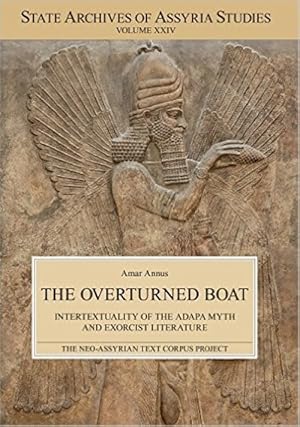ANNUS,AMAR (1 Ergebnisse)
Produktart
- Alle Produktarten
- Bücher (1)
- Magazine & Zeitschriften
- Comics
- Noten
- Kunst, Grafik & Poster
- Fotografien
- Karten
-
Manuskripte &
Papierantiquitäten
Zustand
- Alle
- Neu
- Antiquarisch/Gebraucht
Einband
- alle Einbände
- Hardcover
- Softcover
Weitere Eigenschaften
- Erstausgabe
- Signiert
- Schutzumschlag
- Angebotsfoto
Land des Verkäufers
Verkäuferbewertung
-
The overturned boat. Intertextuality of the Adapa Myth and Exorcist Literature
Verlag: Neo-Assyrian Text Corpus Project, 2014
ISBN 10: 9521094915ISBN 13: 9789521094910
Anbieter: Ruslania, Helsinki, Finnland
Buch
Zustand: new. Pages: 100 Language: English. State Archives of Assyria Studies. Volume XXIV The Adapa myth is a literary work of ancient Mesopotamia with different versions in Sumerian and Akkadian. According to the Adapa myth, the sage and cook from Eridu goes fishing to the Persian Gulf, where the South Wind capsizes his boat. The sage's curse breaks the wing of the South Wind. Adapa lies seven days in the ocean, whence he is summoned to heaven, to be positively judged by the sky god Anu. The present book investigates the literary development of the Adapa myth and argues that it represents an exorcistic version of the flood story with the protagonist as priest. In the Adapa myth, the primordial sage survives the flood, which serves as ideological background for exorcism, ashiputu. The exorcist, who used fire and water as sanitizing substances during the rituals, impersonated Adapa, who had gone through an extreme form of purification himself. Adapa's critical period in the sea was the symbolic etiology for illnesses, difficult births, witchcraft, bad omens, sin, and imprisonment, which the exorcist was able to counter. The deluge was a symbol of water ordeal and judgment, for which the exorcist's assistance was sought. Because Adapa was given rebirth from his disaster, the human exorcist as his embodiment possessed the powers of the flood in manipulating the purifying substances and incantations against all misfortune. The identity constituting narrative of ancient Mesopotamian exorcism is explored with a methodology combining the intertextual studies with cognitive neuroscience. 9789521094910.


